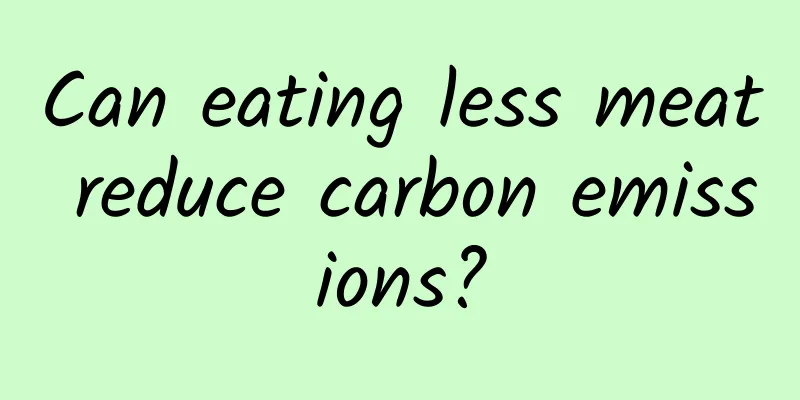Can eating less meat reduce carbon emissions?

|
This year, the temperature has been unusually changeable, extreme weather phenomena have occurred frequently, and natural disasters such as high temperatures, droughts, and floods have been overwhelming. According to statistics, China has experienced 17 tornadoes of medium or higher magnitude from April to September alone, and the most frightening thing is the floods caused by heavy rainfall in Henan. The weather of floods in the north and droughts in the south has also refreshed many people's cognition. In foreign countries, there are also many natural disasters, such as high temperatures caused by extreme weather, forest fires in Australia that have been burning for nearly seven months, and floods in many European countries. The temperature at the North and South Poles of the Earth is also rising. Many permafrost and ice shelves are beginning to melt, and the range of activities of polar bears has been greatly reduced. Many readers may have seen a photo of a polar bear in the hot search. The skinny polar bear stares blankly on a piece of floating ice, which is heartbreaking. In Antarctica, the temperature has exceeded the limit of 20℃. Under the trend of global warming, there are many climate disasters, and humans are suffering from them. Protecting the earth is no longer just an active call from environmentalists, more and more people are beginning to pay attention to the earth's climate and ecology. Regarding reducing carbon emissions, in addition to limiting emissions in industrial manufacturing and production, there are also some voices calling for changing table recipes and reducing the consumption of red meat. Is there any relationship between eating meat and reducing carbon emissions? The neglected carbon emissions of livestock farming When it comes to carbon emissions, everyone's impression is that the burning of fuel energy should be the largest source of emissions. We know that after the Industrial Revolution, humans burned fossil fuels for production, manufacturing, transportation, etc., causing carbon that was originally buried underground and would not see the light of day for tens of thousands of years to be burned in a few decades and emitted into the atmosphere. The scope of human activities has continued to expand, and has also expanded to some lands originally covered by vegetation, such as forests and grasslands. In addition to occupying land, some forest trees are also used as means of production, and this part of nature's carbon-fixing vegetation has also been destroyed. Various human activities such as transportation and fossil fuel combustion have led to a significant increase in greenhouse gases such as carbon dioxide in the atmosphere, changing the carbon cycle in the entire ecosystem. The abnormally enhanced greenhouse effect of the earth has ultimately led to global climate change. In tracking the footprint of carbon emissions from human activities, meat in the diet has also been singled out because of its outstanding "contribution". A report written by 107 scientists from the United Nations Intergovernmental Panel on Climate Change (IPCC) stated that the meat-based diet in the West is accelerating global warming. We know that the dietary structure of Europe and the United States is unique, with red meat as the main staple food. For Chinese stomachs like us, a life without grain staples and only eating meat is simply a torture. Everyone has had this kind of experience: eating a lot of fish and meat for a few days during the Chinese New Year, and the stomach is greasy and uncomfortable. It is simply unimaginable to eat this way all year round. Excessive red meat consumption is not only physically painful, but also a heavy burden on the environment. According to a research report by Greenpeace International, animal husbandry is the largest emitter in the food system, and the greenhouse gas emissions of EU meat and dairy companies have exceeded the total carbon emissions of all cars and trucks in the EU. According to data from the Food and Agriculture Organization of the United Nations, global livestock greenhouse gas emissions are currently about 7.1 Gt of carbon dioxide equivalent, accounting for about 15% of the total greenhouse gas emissions from human activities, and the carbon emissions of the entire food system account for more than 30%. The main carbon emissions from animal husbandry come from fermentation gases and methane in the intestines of farmed animals, greenhouse gases such as methane produced during the treatment of animal manure, and nitrous oxide emitted when manure is returned to the fields. According to statistics from the Natural Resources Defense Council of the United States, 1 kilogram of beef will produce 32.49 kilograms of carbon dioxide. The top five foods in carbon emissions are beef, lamb, butter, shellfish, and cheese. The meat supply in the diet is sufficient and abundant, but the ever-expanding animal husbandry has become a nightmare for the environment, with a wide impact on the ecosystem. Reform and changes in animal husbandry The proportion of carbon emissions from animal husbandry has gradually emerged in various studies and has become a focus of attention and active change by environmental departments. At present, major animal husbandry industries in various countries are mainly adjusting to reduce carbon emissions through the following methods: 1. Change the structure and proportion of animal feed, and reduce the production of methane from animal intestinal fermentation by rationally adjusting the ratio of concentrate to roughage in the diet, using nutritional additives, promoting straw silage, and ammoniation. 2. Treat animal manure, use biogas projects to recycle methane, cover open-air manure storage, and use manure composting to reduce greenhouse gas emissions from manure treatment; 3. Improve animal production performance and reduce greenhouse gas emissions. The IPCC survey report shows that improving livestock productivity can reduce the total amount of animal intestinal methane emissions by 10% to 30%. Meat is a must-have food on the table of modern people. For some people who cannot live without meat, life is meaningless without meat. In foreign countries, meat is the staple food, and it is very difficult for people to stop eating meat or reduce their meat consumption. However, for Chinese people, there are many kinds of edible food, and our staple food is mainly cereals, so it is relatively easy for us to adjust our diet structure. As knowledge of healthy lifestyles has become more widespread in recent years, everyone knows that excessive consumption of red meat itself is risky. The fat in livestock meat is mainly saturated fatty acids, and even the lean meat in pork has 28% hidden fat. From the perspective of nutrition and health, it is also necessary to control the intake of red meat. If you don't have high requirements for food taste, you can also choose to eat less meat. After all, reducing the sale of meat is the fastest way to reduce carbon emissions. Of course, for a large number of people who cannot live without meat, they can also try some alternative artificial meat. With the development of artificial meat in recent years, the taste and flavor of artificial meat have become more and more like real meat. Many people have tried artificial meat, and artificial meat has also moved from the news to people’s tables. Alternative meat products The market for artificial meat is still very hot. In 2019, Beyond Meat, the first artificial meat stock, was listed on the Nasdaq. The market for artificial meat has become hot, especially in Europe and the United States, which began exploring artificial meat ten years ago. Whether it is because of the call of environmentalists or vegetarians, artificial meat has become a new choice on the table for some people. There are two types of mainstream artificial meat: one is "plant meat" made from plant protein, and the other is "laboratory meat" cultivated from animal stem cells using biotechnology. In fact, everyone may have eaten the earliest form of "plant meat". It can often be seen in many domestic snacks, where soy products are made into various meat-flavored foods. The raw materials of plant meat are basically beans. After extrusion, puffing and other processes, it is processed into a meat-like taste with seasonings. This kind of "plant meat" still has a little difference in taste from real meat, but the taste is still quite similar. If you are not picky, it will have almost no effect. Large fast food chain brands such as Burger King, McDonald's, and KFC already have products such as plant meat burgers. Domestic start-up plant meat companies have also launched plant meat products in many Internet celebrity restaurants. The materials used in the products of some Internet celebrity restaurants, such as dumplings and wontons, are all plant meat. However, the technology of artificial meat in the laboratory is not mature enough, the production cost is high, and there are few commercial products. The market response is not very enthusiastic, and many consumers have this idea: Why eat artificial meat (laboratory meat) when there is real meat? Is this meat safe? The market education of "laboratory meat" is not sufficient, so the common artificial meat on the market is mainly "plant meat". Of course, the target population of artificial meat has never been just vegetarians. For meat eaters who pursue a healthy diet, artificial meat is also a good substitute, which takes care of both the mouth and the body, killing two birds with one stone. Adjusting the dietary structure is not a simple and easy thing. It is difficult for many people to change their habits of many years, not to mention the great advocacy of the nutritional value of red meat by modern nutrition science, which is mainly based on the West. First of all, it must be admitted that meat protein is very valuable and important for humans, but poultry and aquatic meat protein can also meet health needs. Poultry and aquatic products have always been known for their high protein, low fat and high nutrition, and can replace the nutritional value of red meat. Europe and the United States, which consume the most red meat as the staple food, need to take responsibility to change the national cognition and eating habits. Many vegetarians may have watched the documentary "Earth Citizens". In my opinion, this film is a bit heavy and even a bit scary. It shows many scenes of slaughtering animals. We can see the whole process of animals from birth to the table in the film. There is a sentence in the documentary that impressed me very much. It means: if humans eat meat not simply from the supermarket shelves, but participate in the whole process of slaughtering animals, going through the processes of skinning, cutting, cleaning, etc., then many people will not choose to eat meat. The extreme development of slaughtering industry makes it easy to obtain meat. Many children born in cities have no idea where meat comes from. What we see on the shelves are neat pieces of meat. Meat is like vegetables, snacks and other items. It is easy for people to ignore its source, and it is even more impossible to measure it in terms of the value of life. I really hope that everyone will watch the documentary "Earth Citizens" and get some inspiration from life. This documentary may change your diet structure. The starting point of eating less meat may not only be from the health level, but also from the perspective of life. Of course, I am not kidnapping anyone. After watching the documentary, no matter what diet you choose, health and suitability are the most important. |
<<: NASA finally admits! Going to Mars is to search for alien life
>>: Human foodies "catch strong men", female coconut crabs can't find a husband
Recommend
Two major ideas for attracting new users
Any product or project faces the problem of new u...
6 big family happy events in the IT industry in 2015
A few days ago, there was a rumor in the IT circl...
Floor heating, fireplace, incense burner in the quilt... this is how the ancients spent the cold winter
Faced with the bitter cold winter, as people livi...
As the number of fans in Greater China continues to decline, what is the point of Apple betting on India?
Recently, Apple released its first quarter financ...
Can’t come up with the copy for information flow advertising? There is a template here, just use it!
Many friends often complain to me: " Informa...
"Investment and Business" advanced course!
"Investment and Business" 2020 Advanced...
Problematic cribs named! How can you buy a safe and reliable crib?
Infancy is a period of rapid growth and developme...
Zhan Falcon "Easily defeat procrastination and take back the initiative in life"
Course Catalog: Pilot Course - Course and Teacher...
If Darwin were alive today, he would rethink "The Origin of Species"
Anyone who has seen the movie "Prometheus&qu...
Zhang Kaili’s personal profile: What is the purpose of website structure optimization?
We know that website structure is a very importan...
Door-to-door service is not a cure-all for Isatis root
2014 was the year of the O2O industry explosion. ...
What kinds of data are mainly analyzed for SEM optimization? How do novice SEM users perform data analysis?
SEM is the abbreviation of Search Engine Marketin...
Europe is the next battlefield for Chinese automakers. Will Ideal Auto establish a production base in Norway?
Recently, some media broke the news that Ideal Au...
Many snacks failed the random inspection! Microbial contamination, excessive additives... Many people don't understand these hazards
Expert of this article: Pa Lize, Chief Physician ...
You can eat meat without worrying about it! Vegetarianism has limited effect on mitigating climate change
"Every time the Chinese eat a piece of meat,...









